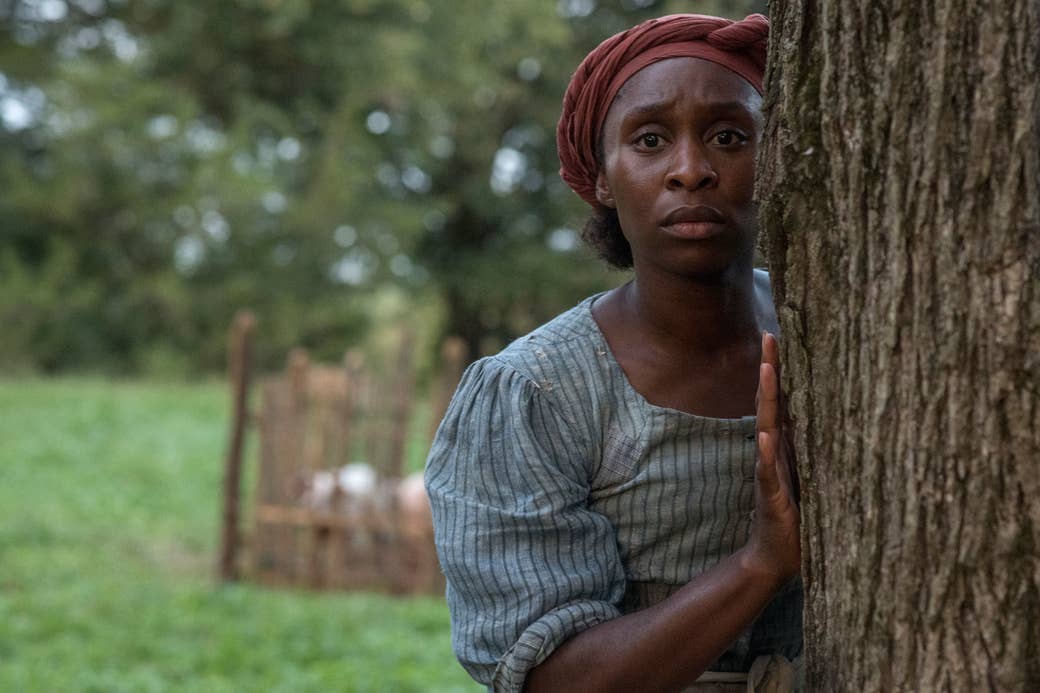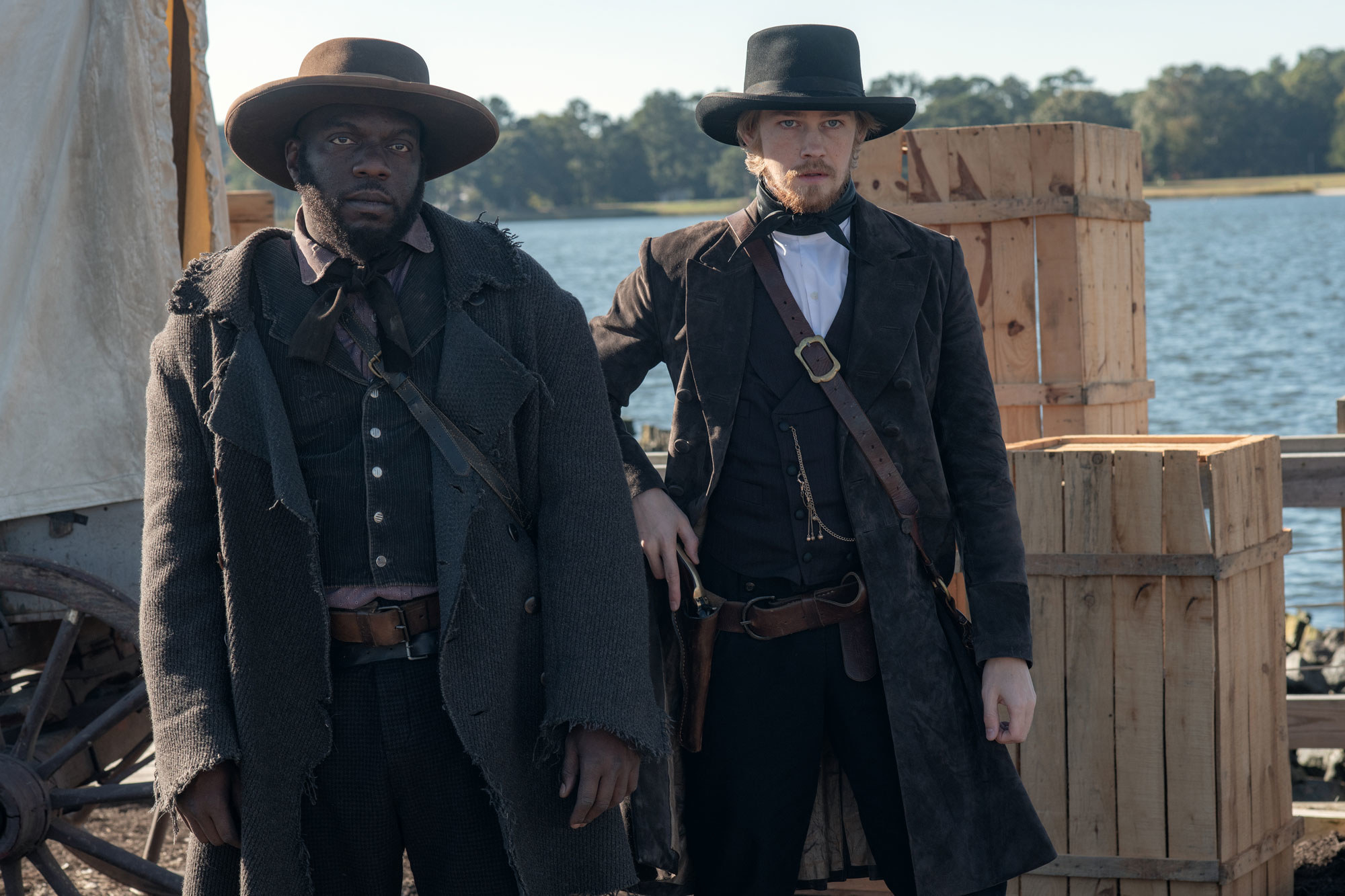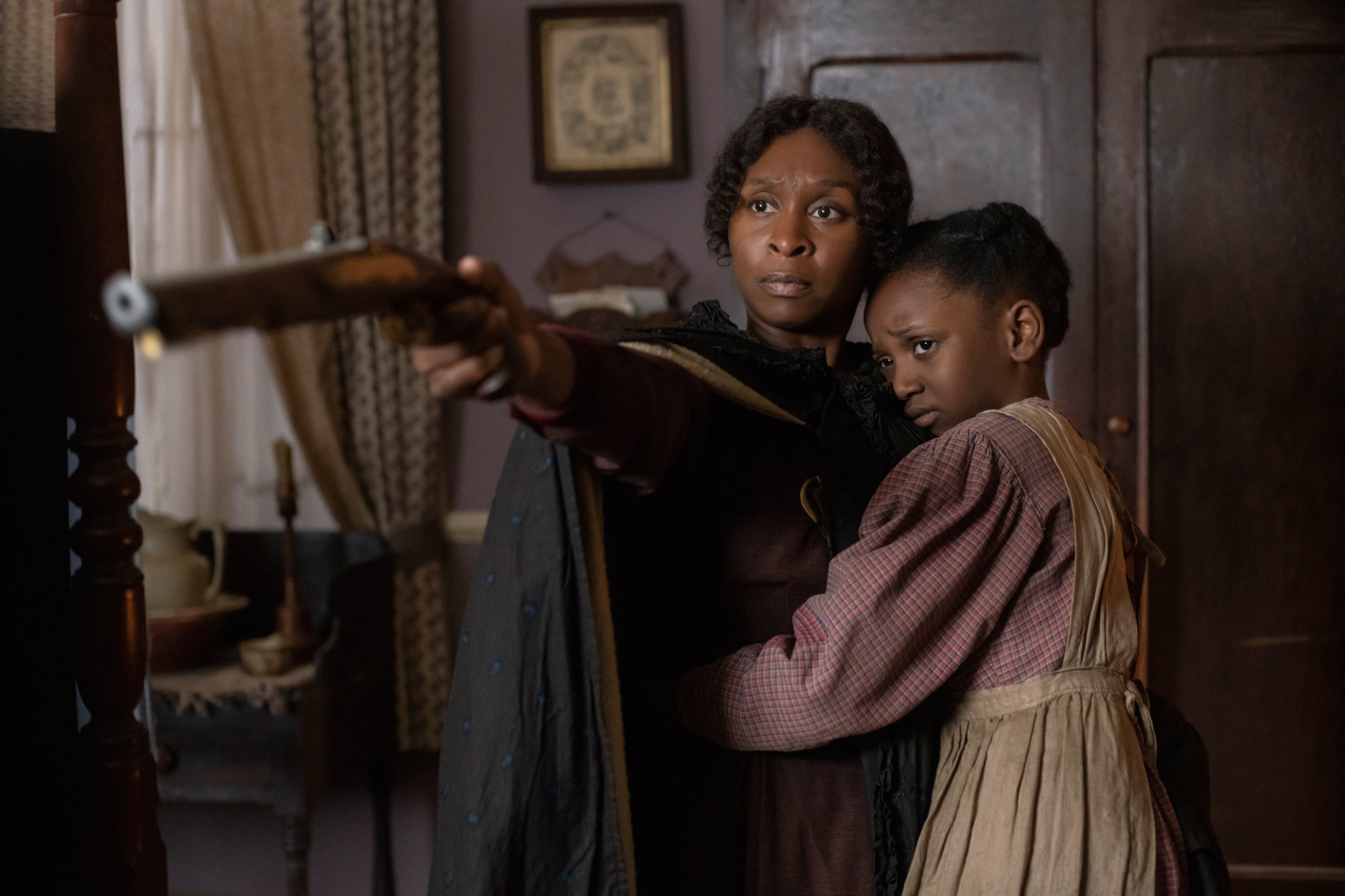
It is not unusual for dramatic license to be taken when a writer or director is creating a narrative based on actual events. However, with Harriet, the recently released biopic of the iconic historical figure Harriet Tubman starring Broadway star Cynthia Erivo and directed by Kasi Lemmons, such creative license has come under scrutiny.
The inclusion of a fictional black bounty hunter named Bigger Long (Omar Dorsey), as well his death at the hands of Harriet’s “master,” Gideon Brodess (Joe Alwyn), has upset a faction of Twitter users who believe these creative liberties were in poor taste. They have called for people to refrain from seeing the film, using hashtags like #NotMyHarriet — which, at first, stemmed from a controversy surrounding Erivo’s casting in the title role of a black American hero (the actor is British, born to Nigerian parents). Now the hashtag has become a vessel for the brewing conversation around the film’s supposed white savior narrative.
Calls for the movie to be boycotted because of that purported trope highlight some thorny topics, like the purpose of biographical art — and its responsibility to the truth — and whether someone can critique art without having first seen the project they are assessing.
Lemmons, who previously directed 1997’s Southern gothic classic Eve's Bayou and is herself a black woman, spoke with BuzzFeed News at length about the controversy in a phone interview on Tuesday afternoon. She called the film’s white savior criticism “completely ridiculous.”
Black stories are often warped in order to appear more palatable or sympathetic to white viewers.
The chorus of voices dissatisfied with the first feature-length telling of Tubman’s story is representative of a very real issue: Black stories are often warped in order to appear more palatable or sympathetic to white viewers. Hidden Figures (2016) — a movie that should’ve been interesting enough based on the fact that it’s about a real-life team of black women who contributed significantly to NASA during the space race — featured a fictional white man, Al Harrison, played by Kevin Costner, who dramatically destroys a “colored ladies room” sign hanging above a restroom in protest of segregation — as if in assurance to white audiences that not all white people are bad. And who could forget The Help (2011), a film Viola Davis admitted she regretted appearing in, even though the role earned her an Oscar nomination, because the movie centered around the white journalist played by Emma Stone instead of “the help” themselves. 2013’s 12 Years a Slave also included the storyline of a redeemable white person played by Brad Pitt, who produced the movie and whose character one reviewer wrote had “messianic qualities.”
So when Asia Chloe Brown, a “project manager by day, urban farmer and food justice organizer by night” who often tweets about pop culture, told her 28,000 followers to avoid Harriet because of what she saw as its use of the white savior trope, her tweet went viral — even though, at that point, she had only seen the trailer. “They really made up a Black man bounty hunter who almost kills Harriet Tubman in the movie,” she tweeted last Friday, the day the movie premiered in theaters. “A White slavemaster kills this Black man to... protect Harriet. They completely made this shit up out of thin air. DO NOT SUPPORT THE HARRIET MOVIE.” The tweet has now been favorited nearly 40,000 times.
In a phone conversation with BuzzFeed News on Monday, Brown said she stood by her assessment “100%” and did indeed see the movie after tweeting, in case she had to “walk back” her initial criticism.
“If I had seen it before my tweet, I can admit that I would have changed the word ‘protect,’” Brown told BuzzFeed News, adding that the white slaveholder character Gideon “obviously didn’t want to protect Harriet from harm. He was more so looking for ownership of the harm he wanted to enact on her.”
During the scene in question, Harriet tries to scale a rock to evade capture from Bigger and Gideon. A few gunshots are exchanged between Harriet and Bigger before one of her bullets hits the bounty’s hat, knocking it off his head. Upset by Harriet’s nearly shooting him in the head, Bigger becomes enraged, saying, “You gon’ die, bitch!” Before Bigger can fire his next shot, however, he’s fatally wounded by Gideon, who has been pursuing Harriet for years. “Alive, I said,” Gideon says, lowering his gun. It’s this moment of Bigger’s death specifically that Brown interpreted as a “white savior” narrative. Later in the film, however, there’s another scene in which Harriet and Gideon come face to face, and Harriet, quick with her hands, disarms and wounds her would-be captor, saving her own life in the process.

Even though she would have amended the wording of her tweet, Brown said she would still consider the film to be an example of the white savior trope. “White saviors don’t always need to be these cuddly figures; they don’t need to be a friend, they don’t need to be a lover,” she said. “They just need to be a white person who controls a destiny or controls an outcome.”
According to Lemmons, this reading of the scene “goes completely against what we call white savior films. He’s a slave owner. It’s completely untrue.”
Brown is not alone in her thinking, as illustrated in a review of Harriet by writer Brooke Obie for Shadow and Act: “And sure, the enslaver was the sole reason the bounty hunter was hunting Harriet in the first place,” Obie wrote. “Still, it is unsettling to watch this enslaver save Harriet's life from a violent Black man.”
Though Lemmons has been criticized for including a black “slave catcher” within Tubman’s tale, her choice isn’t an ahistorical one. According to Joshua Rothman, a history professor at the University of Alabama, there were indeed black slave catchers, he recently told Slate. Outside the South, he said, “We know that rings of kidnappers used free black people to lure in their prey,” since they were “far more likely to trust a black person than a white one and ... wouldn’t realize they’d been duped until they were en route to being sold as a slave.”
Lemmons told BuzzFeed News that her research for the project also confirmed that there were black bounty hunters during this period. She almost nixed the character, however — not because “it was unrealistic,” she said, but because “it was almost a trope.” A version of the Bigger character appeared in the original script from Lemmons’ cowriter, Gregory Allen Howard, and the director ultimately grew fond of the idea of using the hunter as a vessel “to present what was a very complex portrait of African American life.”
According to Lemmons, this reading of the scene “goes completely against what we call white savior films. He’s a slave owner. It’s completely untrue.”
Although black slave catchers were a relative rarity, the film demonstrates that there really is no such thing as a black body unencumbered by the constraints of a country founded on the idea of slavery. The character of Marie Buchanon (Janelle Monáe), for example, is born free but dies at the hands of Bigger, who is only doing this type of work as a means of survival. Bigger may have been the person who committed this crime, but the ultimate blame belongs to the country's white supremacy, which fostered an environment where he forsakes the humanity of his own community. In doing this work, for a fleeting moment, he isn’t at the bottom of the social rung.
“In the corrupting system of slavery, there were people who worked for the wrong side,” said Lemmons, adding, “In looking at what can a black woman bring to the film, I was really trying to create a rich and textured portrait of African Americans in America.” The director said she was struck by how difficult it was for anyone to trust each other at this time in US history, noting that people would sometimes work to help free people who were enslaved and then betray the folks that they’d once helped. “To me, Bigger Long is just part of the corruption spilling over into the character, so not just making everything black and white in terms of good and evil, because that wasn’t true,” she said.
With a prominent historical figure like Tubman, it’s not hard to see why black people are so protective of the specific way her story is laid out for the world to consume, particularly in a far-reaching medium like film, and especially when the hero is already the source of an often misquoted phrase: “I freed a thousand slaves. I could have freed a thousand more if only they knew they were slaves.”
“To me, Bigger Long is just part of the corruption spilling over into the character, so not just making everything black and white in terms of good and evil.”
Does the fictional representation of a black man reading part of the Gettysburg Address in Steven Spielberg’s Lincoln (2012) change the heart of the story the director sought to bring audiences or grossly misconstrue actual history? The same could be asked of fictional black soldiers in the 1989 film Glory, who were used as stand-ins for the real-life heroes whose shoes the actors attempted to walk in. When people leave the theater after seeing Harriet, will they believe she actually encountered a black bounty hunter? Will they believe a white slaveholder was, in some small part — because he did not kill her during that pivotal scene — the reason why the legendary hero was successful in helping others to freedom later? And would those misconceptions matter?
Historical fiction can certainly perpetuate plenty of harmful tropes. The whitewashing of slavery-era relationships is all too common; so are bizarre historical fiction films that have tried to sell audiences on ridiculous relationships, like a black woman who falls in love with a Nazi (seriously!).
In practice, it seems that these questions are ultimately up to audiences to answer for themselves. To what extent do viewers understand that historical fiction is just that: fiction? And since when has a single filmmaker’s take on a biographical subject’s life been deemed the definitive be-all and end-all of that person’s story — or even a stand-in or alternative to primary source material, for that matter?

The criticism of Harriet comes at a time when the perspectives of black people are being represented in film and television more than they have in the past, which means many viewers have justified fears about exploitation and how underrepresented people are portrayed on camera. That uneasiness is why Harriet is not the first movie by a marginalized director to face calls for boycotts from the community it represents before the movie is even released. In a piece about the backlash to the movie Adam, directed by Rhys Ernst, who is trans, my colleague Shannon Keating wrote: “Hollywood continues to reckon with its historic lack of marginalized voices and devaluation of marginalized labor; and when online outrage and misinformation campaigns can fuel so-called cancel culture.”
Though Harriet received a healthy amount of criticism from people online, it performed better at the box office than expected in its opening week, raking in $12 million. The film also boasts an A+ grade on CinemaScore, an indication that people enjoyed it.
“There’s so much in this long life, this big, storied life,” Lemmons told BuzzFeed News. “You can make many movies on Harriet Tubman, but I thought to really delve into the part of her life that in some ways we think we know, and to really get in and look at it in a detailed way would be an exhilarating journey.” Lemmons was very much interested in “narrowing the lens” of “this extremely active part” of Tubman’s life.
Lemmons revealed that the film’s script originally had more plotlines related to the Civil War, which she regrets cutting; making difficult choices about what to leave in and out is the norm when producing a big, ambitious film like Harriet. Filmmakers have to weigh these kinds of decisions when bringing someone’s real life to the big screen; Lemmons pointed out that not even documentaries are immune: “You make dramatic choices and you narrow time frames. As storytellers we make choices, and this was my choice.”●
